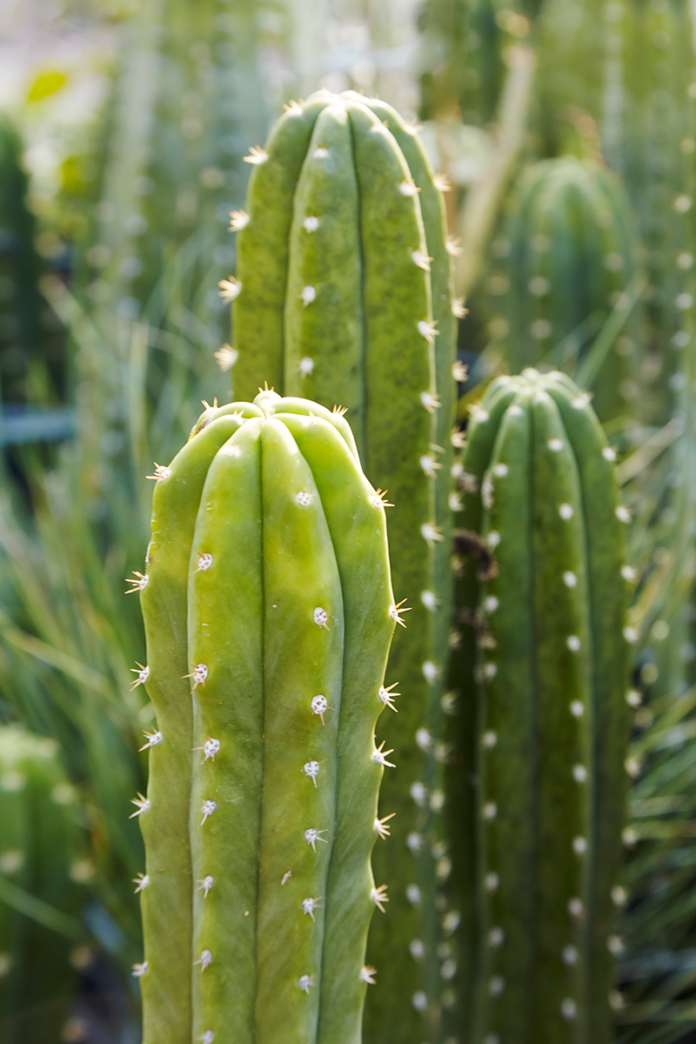San Pedro, also known as huachuma, is a large, thin, column-shaped cactus that grows in the Andes mountain range, in South America. The active psychedelic ingredient in San Pedro is mescaline.
Traditionally, San Pedro is either consumed alone or in ceremony with other plants in a traditional brew called cimora. When taken alone, San Pedro can be swallowed as a powder, or mixed with water to create a tea.
What is the San Pedro experience like?
After consuming San Pedro, psychedelic effects begin within 15-40 minutes. Participants may feel tingling, as well as some nausea or dizziness at the start of the journey. The peak experience often includes strong, colorful visual effects, synesthesia, distortions of spatial awareness, and out-of-body experiences. It can take up to three hours to reach the peak of the session, and effects are felt for up to 10 hours in total. San Pedro is an empathogen, like MDMA, meaning that it creates a strong sense of empathy, emotional connection, wonder, and awe.
A Brief History of San Pedro
Various indigenous people groups in South America, and particularly in Peru, have used San Pedro in religious and spiritual ceremonies for at least 3,000 years (Rudgley, 1998). One of the earliest visual representations of the San Pedro cactus is a carving from the Chavin culture (c.1400-400 BC), located in an ancient temple in the Peruvian highlands. The carving shows a mythological creature holding San Pedro.When European missionaries arrived in the Americas, they perceived San Pedro negatively and discouraged its use. The plant’s status as a sacred entheogen has not wavered, however, in spite of persecution. In recent years there has been a resurgence in its popularity, and there are currently many retreat centers and organizations that offer San Pedro ceremonies in South America.
San Pedro Safety
Although long-term research is limited, mescaline (the primary psychoactive ingredient in San Pedro) appears to be relatively safe. There are no known incidences of a lethal mescaline overdose, and a lethal dose has not yet been identified.
At very high doses, however, adverse effects can include hyperreflexia, tachycardia, agitation, muscle stiffness, ataxia, seizures, mydriasis, sialorrhea, hyperthermia and paresthesia (Dinis-Oliveira, Pereira, Dias de Silva, 2019). Some adverse effects appear to be limited to naturally-occurring mescaline, such as is found in San Pedro.
One study examined the use of mescaline-containing cacti in a ceremonial context among Native American populations and found no adverse effects (Halpern et al., 2005). In studies involving extremely high doses administered to lab rats, there was some evidence of impairment to problem-solving and memory, but the doses in the study far exceed any known human dose (Koupilová, Henrink & Krs, 1999).
Links have been established between mescaline and fetal abnormalities, so pregnant or breastfeeding women should avoid San Pedro (Meyer, 2011).
San Pedro should not be consumed by individuals who have a heart condition or chronic hypertension. San Pedro should not be mixed with other medications or substances, especially medications for hypertension, alcohol, tramadol, immunomodulators, and stimulants (e.g. amphetamines or cocaine).
When ingesting San Pedro, always follow basic psychedelic safety recommendations, including attention to set, setting, and sitter. Check out the PEx general safety guide.
San Pedro Science
Pharmacology
The active psychoactive component in San Pedro (huachuma) is naturally-occurring mescaline. Mescaline has a phenethylamine structure. As a phenethylamine, it is similar to MDMA, but falls in a different class from tryptamines, such as LSD, DMT, and psilocybin.
Like most psychedelics, however, mescaline acts upon the brain’s serotonergic system, particularly serotonin 2A receptors. In addition to interacting with serotonin receptors, mescaline activates the brain’s dopaminergic system and binds with dopamine receptors.
Therapeutic Use
In comparison with other psychedelics, studies on the therapeutic potential of San Pedro remain limited. There are many anecdotal accounts of life-changing experiences with San Pedro, but little formal research has been conducted at this point.
There is some evidence, however, that mescaline, the active ingredient in San Pedro, increases activity and blood flow in the prefrontal cortex of the brain. Lower levels of activity in the prefrontal cortex are linked to anxiety and depression, suggesting that mescaline may be useful in treating certain mental disorders, particularly mood disorders.
Mescaline’s interactions with both serotonin and dopamine receptors imply that it can help to boost mood and treat depression. In traditional Mesoamerican cultures, plant-based cacti, like San Pedro, was used to treat depression (Horgan, 2009). Its pharmacological similarity to MDMA also suggests a possible use in the treatment of PTSD.


